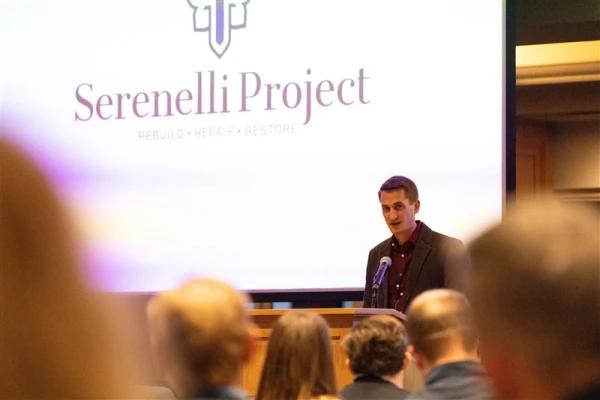NFL’s Harrison Butker, Notre Dame give $10,000 to group creating ‘monastic village’ for ex-prisoners
CNA Staff, Nov 11, 2023 / 06:00 am
An initiative to help former inmates reenter society and grow in their Catholic faith is the winner of a $10,000 award sponsored by the University of Notre Dame and MDKeller, the holding company of two-time NFL champion Harrison Butker.
The award recognizes and supports individuals or organizations with bold ideas to best use underutilized Church property.
The winning initiative, called the Serenelli Project, is a nonprofit organization in Cincinnati that has a goal of creating a “monastic village” for former inmates who wish to live in an intentional Catholic community as they readjust to life outside prison, the website says.
Additionally, those community members will work together to refurbish an abandoned and decommissioned Catholic church to hone labor and trade skills and to restore the historic building in order to enrich the local neighborhood.
“We’re simply trying to help people stay in their faith when they get out of prison,” Marty Arlinghaus, founder and volunteer CEO of the project, told CNA on Thursday, after winning the award on Oct. 31.
The Serenelli Project was chosen among more than 130 applications at Notre Dame’s Church Property Conference run by the school’s Fitzgerald Institute for Real Estate in October.
Austin Wright, MDKeller’s co-founder, said that “we could not be more excited for Marty and everyone at the Serenelli Project for being the first recipient of the MDKeller To the Heights Award.”
“Organizations like this are going to create positive shifts in the culture for generations to come,” he added.
David Murphy, the program director for the Church Properties Initiative at the Fitzgerald Institute for Real Estate, said: “How better to use a closed church than to meet the needs of prisoners who feel marginalized that can serve as a beacon of hope for both the community in Cincinnati and indeed the world?”
“The Serenelli Project embodies the highest and best social, fiscal, and spiritual use of property,” he said.

A faith community
Arlinghaus, 31, said that the project will first focus on men who were former inmates and hopes to have individuals living in the community as early as May 2024.
The plan is for the men to live in houses, owned by the Serenelli Project, surrounding Our Lady of Perpetual Help Church, in Sedamsville, a neighborhood of Cincinnati. Currently, the project owns and is renovating one house with a chapel inside near the church.
The 19th-century Our Lady of Perpetual Help Church was closed in 1989 by the Archdiocese of Cincinnati and was sold to a developer years later but is now owned by the The Port of Greater Cincinnati Development Authority.
Arlinghaus is hoping to buy the church and its rectory from the port authority with the intention of refurbishing the historic establishment to be used once more.
The ex-inmates living in the community will play a large role in the renovation of the church, he said.
The Serinelli Project will partner with tradesmen and construction companies and offer their members as laborers. Through this work, the former inmates will begin to develop a craft in the trades and use these skills to develop a career, as well as to refurbish the church.
Eventually, Arlinghaus hopes to have trades professionals who work for Serenelli Project that will train community members and lead the work on the church and with external jobs.
Arlinghaus said that his vision is for the members of the community to receive spiritual formation from a priest in residence during their time of labor and reentry.
The total cost of buying the church, rectory, and their restoration will cost millions, he said, but he’s not worried about reaching the fundraising feat.
“We have the next thousand years to make this look like what God wants it to look like,” Arlinghaus said. “I’m not worried about raising that much money to do the full restoration in a quick amount of time. This is something that gets built up slowly in the Spirit more than it does physically.”
Although its first large undertaking will be a community for men, the Serenelli Project also serves women and anyone else reentering society who doesn’t want to live in community but still wants help in their faith. Some of those services include connecting these individuals to parishes in their area, counseling services, and “spiritual encouragement.”
Namesake
The Serenelli Project is named after Alessandro Serenelli, the man who in 1902 attempted to rape and then murdered Maria Goretti, who was later canonized a saint.
Serenelli served a 30-year prison sentence but repented for his sins after the saint appeared to him in a vision and offered him 14 lilies representing her 14 stab wounds.
His life was changed in that moment and when he left prison he asked forgiveness from Goretti’s mother, which she gave. Serenelli lived the rest of his life as a Third Order Franciscan, working on the religious order’s monastery grounds until his death.
In a letter dated May 5, 1961, Serenelli wrote: “At the age of 20, I committed a crime of passion, the memory of which still horrifies me today.”
“Maria Goretti, now a saint, was my good angel whom God placed in my path to save me. Her words both of rebuke and forgiveness are still imprinted in my heart. She prayed for me, interceding for her killer,” he wrote.
Arlinghaus said: “We’re trying to create the same community for guys like him.”
Recruiting
Attracting men to live in the community is a large task, but Arlinghaus is hoping that his position in the Archdiocese of Cincinnati as the director of prison ministry can help.
Arlinghaus oversees the ministry’s three prisons and spends much of his workweek in the prisons with inmates.
He said that in one of the prisons there are about 25-30 men who show up each week to the prison ministry and many are joining the OCIA (formerly RCIA) program for those coming into full communion with the Catholic Church.
He hopes that through his relationships with men in the prison, the project will be able to identify individuals who will be interested in living in the community.
The idea for the Serenelli Project, after all, began in prison.
One day, an inmate said to him, “Marty, could a guy like me become a priest?”
“And this just was a question that blew me away because I’d never thought these guys would be thinking about that,” Arlinghaus said.
Researching the answer, Arlinghaus began to think about the simple difficulties of “making it in a Catholic parish.”
Many of the inmates come to faith while in prison, but when released, “know nothing of the Church on the outside.”
From that one inmate’s question, The Serenelli Project was born.
To hear Marty Arlinghaus speak more about The Serenelli Project, check out the video below.













